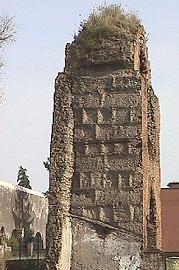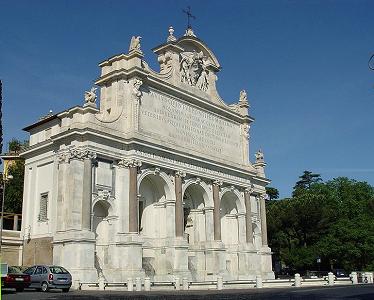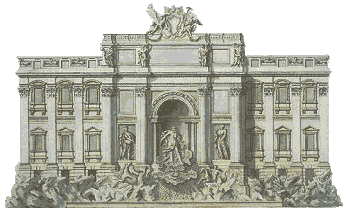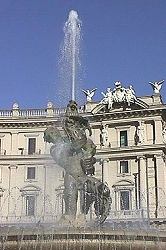As the city expanded again after its darkest age, the water
supply that the old Aqua Virgo could offer was insufficient,
and its availability mainly concentrated in a small part of the urban area.
Restoration works had been carried out many times, but the medieval
architects had an insufficient knowledge of hydraulics, and relied on limited
technical means, so that the duct's course had been shortened, and the water
was no longer drawn from the original springs, but
from smaller ones closer to the city: besides its reduced quantity,
also its quality and purity (whence its taste) were not as good as in ancient
times.
Pope Paul III (1534-49) had been wisely advised to restore the original course of
the aqueduct, but due to political problems he never did so.
His successor
Pius V encountered another problem: a strong rivalry between the architects who
wanted this important commission; each of them did their best to
criticize the other projects, and this resulted in a further delay. |
|

the Salone Water (ancient Aqua Virgo; A · original springs, B · during the Middle Ages)
and the Aqua Felix |
Nevertheless, the works started, but two more popes (Pius VI and Gregory XIII)
reigned before the Aqua Virgo, renamed Salone Water after the village next to
the springs, was finally restored to its original flow, in 1570.
This was immediately followed by the making of a net of underground ducts,
that enabled the water to reach several districts (see
Fountains, part III
page 2 for more details).
Rome kept growing at a very fast rate, and the water was still not enough,
especially for some important districts, such as the Capitolium hill and its
surrounding areas, not reached by the Salone water.
A project for reactivating the springs of the ancient Aqua Alexandrina was
agreed under the same pope Gregory XIII, but he died soon after the works
had started (1585).
Who had most of the second aqueduct built was Sixtus V (Felice Peretti, 1585-90).
As a cardinal, he owned Villa Montalto on the Esquiline hill, a very large estate that included the site of today's Termini railway station.
The course of the new aqueduct would
have passed by the pope's villa, considerably increasing its value, also because
it would have enabled the making of new fountains in its gardens.
This explains why Sixtus V was so eager for the water to reach Rome
as soon as possible: only a few days after his election, the works were resumed.
The pope gave the new aqueduct his own name, Aqua Felix, which sounded as
"happy water", although it was not really born under a lucky star (see
Fountains, part III
page 6).

remains of the Aqua Claudia: note the
square marks of the stolen blocks
|
At first, maybe due to a hasty project, the
architect in charge (Matteo Bartolani, a.k.a. Matteo di Castello) helped
by a commission of experts, could not avoid mistaking the hight of
the new viaducts that should have integrated the broken ancient remains: so
the water, that initially flowed from the original springs in Pantano towards Rome, at a certain point sloped back. The pope, furious for having wasted money and time,
appointed a different architect, Giovanni Fontana, who found new springs next to the old ones,
but at a higher level, enough to let the water reach the city.
The course followed by the Aqua Felix was basically the same one of the
ancient Aqua Marcia and Aqua Claudia, from whose remains
a great amount of building material was taken. Several pillars of the Aqua Claudia now
bear the prints of the original blocks of stone, taken away and reused for the new
aqueduct. |
While almost nothing of the Aqua Marcia was left after
Sixtus V's works, the steady parts of the Aqua Claudia were also used
for the new viaduct as a support:
in some parts the Aqua Felix was built resting against the early roman structure,
clearly distinguishable because taller than the one built in the late Renaissance.
It still runs all the way from Pantano to Rome, crossing the city's modern
south-eastern suburbs, once open countryside
(see picture on the left and part III). |

suburban stretch of the Aqua Felix (1585)
|

the Fountain of the Aqua Felix:
Moses is the central figure |
As a final output for his Aqua Felix, Sixtus V
had a large fountain built by the remains of the Baths of Diocletian.
Below a large inscription that remembers the making of the aqueduct by the pope,
three tall niches are divided by columns; the central one houses the imposing figure of Moses.
Once set into place, though, this statue turned out
quite stout and disproportionate; the people of Rome, accustomed to much finer
works of art, strongly criticized it and laughed upon what they called the
"ridiculous Moses". Once again, the Aqua Felix turned out not very "happy".
Despite the incident, by the end of the 16th century most parts of Rome
were once again reached by running water.
|

the "ridiculous Moses"
|
|
17TH CENTURY
Only the western districts, such as
Regola, Trastevere and Borgo, were still rather dry. The little water
that the Aqua Felix could carry to the opposite side of town
(see also
Fountains, part III,
page 11) was certainly insufficient to cover the needs of the population.
Even the rich families who dwelt in this part of Rome, such as the Farnese,
still had to draw the extra water needed from the Tiber or from the
fountains that already worked, or buy it from water-selling pedlars.
At the beginning of the following century, pope Paul V had the ancient
Aqua Traiana completely restored, and renamed Acqua Paola after himself.
The works ended in 1618, but the
aqueduct's "display", i.e. the huge fountain on the Janiculum hill (see Fountains,
part III, page 12), was finished no sooner than in 1690.
Due to its size, to the roman people still today this is "the big fountain".
According to a blameful custom, though, for its making several
blocks of marble were taken from the remains of temples and buildings in
Trajan's Forum. |

the "big fountain" |
As the ancient Aqua Traiana had done in the past, also the Acqua Paola supplied the whole west end
of the city, no longer limited to Trastevere, as also the Vatican's area (Borgo district) had recently become a part of Rome.

a view of the fountain of Paul V, by Sisto Bridge, and the huge
fountain of the Acqua Paola in the background, on the Janiculum hill |
Another nearby important fountain, though not as huge as the previous one, shared the same water.
Originally located at the southern end of via Giulia, on the opposite side of the Tiber,
it had been commissioned by the same pope Paul V for the benefit of Regola district.
But in the late 19th century high walls were built along the Tiber banks, to prevent further floods, and the project entailed the demolition of several houses; in order to preserve the fountain, it was disassembled and rebuilt on the side of Sisto Bridge, belonging to Trastevere district, where it now stands (more details in Fountains,
part III, page 12). |
18TH CENTURY
The Aqua Virgo is the only ancient aqueduct which has been continuously active
since its making, in the 1st century BC.
In 1453, on the occasion of one of the many restorations, pope
Nicholas V altered a part of its course and decorated its main output with a fountain
whose shape is known thanks to an engraving by G.Vasi (early 18th century).
About three centuries later, attempts were made to improve the fountain's look, but
a number of unlucky projects were rejected. Then, in 1751, Francesco Salvi was finally
given the commission by Clement XII for the creation of the world-famous
work known as the Trevi Fountain (see Fountains, part III, page 17),
which became one of Rome's symbols. After the making of this enormous "display", the water
carried by the Aqua Virgo has also been called "Trevi water": it was still appreciated as an excellent drinking water
in the second half of the 20th century, at the point that in the 1930s a further
alteration was carried out to the urban part of the aqueduct's course, to improve its
flow rate. Most important fountains in central Rome still today receive the Aqua Virgo
through its many secondary branches.
|

(above) the 15th century Fountain of the Aqua Virgo, and
(below) the 18th century version, from the original project
 |

the central figure of the
Fountain of the Naiads
|
19TH CENTURY
In 1870, only a few days before the Italian army conquered Rome, pope Pius IX opened
an aqueduct he had sponsored, called Acqua Pia-Marcia, which partially followed the ancient
course of the Aqua Marcia.
The spot for its main output was chosen not far from the site where the castle of the
roman aqueduct once stood. Its location, though, was slightly shifted only a
few years later, and the output was replaced with the large Fountain of the Naiads
(more about this fountain may be read in Curious and Unusual,
page 9, and in Fountains, part III, page 19).
20TH CENTURY
Besides the alterations carried out to the Aqua Virgo in 1936, a completely modern aqueduct was
not built in Rome before the end of WWII.
|
An important water supply for the new districts, rapidly developing off the city center,
came from the Peschiera aqueduct, whose first branch was completed in 1949, and had a second
branch opened in 1964; from its springs, located next to Rieti (about 60 km or 37 mi
north-east of Rome), it enters the city from the north-west. Its main output is in piazzale
degli Eroi, by the Vatican's northern boundary, see Fountains, part III, page 21.
|

the fountain in piazzale degli Eroi, final output of the Peschiera aqueduct |
Lastly, a further aqueduct, the Appio-Alessandrino, was built in 1965 for the south-eastern
side of town, whose increasing water needs could no longer be covered by the
Acqua Pia-Marcia alone.